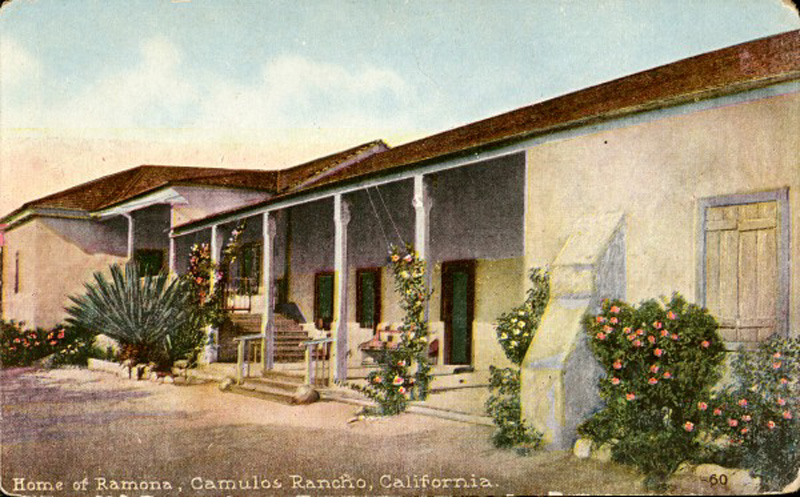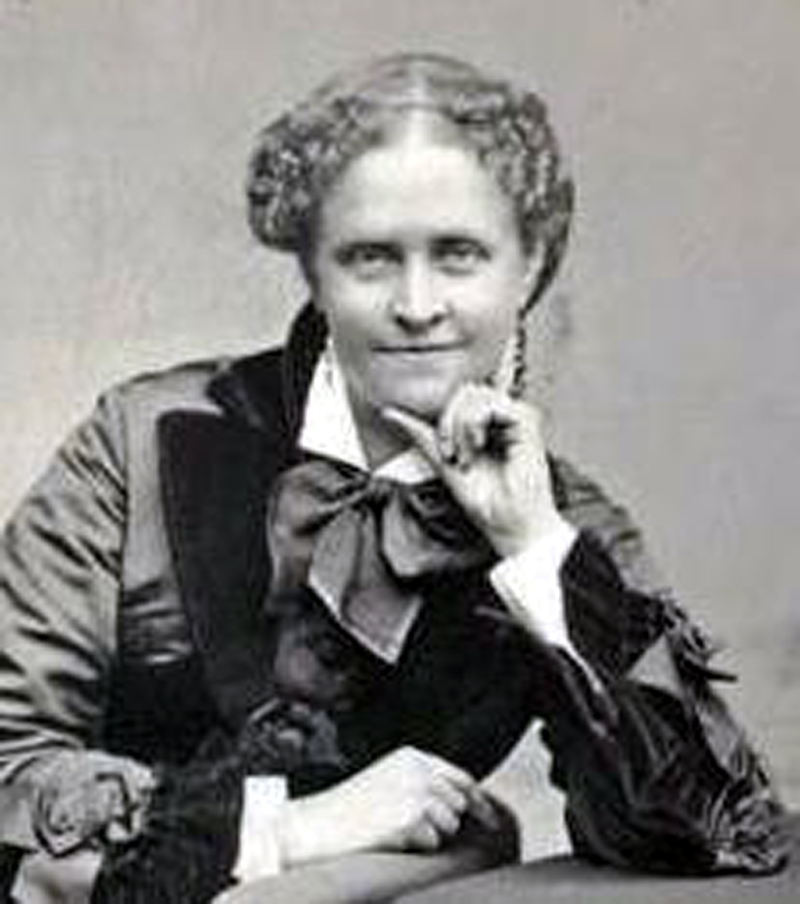|
|
Myth of Ramona Revived in Ventura
By Leon Worden
SCVHistory.com | Friday, October 30, 1998
|
Century of Dishonor," published in 1881, was one of the first tomes to chronicle the U.S. government's mistreatment of Native Americans. With a subsequent work, initially printed in serialized form, Helen Hunt Jackson set out to relay "some Indian experiences in a way to move people's hearts." Sadly, Jackson died before she could see her novel achieve the desired effect.
In truth it may not have moved people's hearts so much as it moved their feet. California was in the throes of a major westward migration in the 1880s. Wagon trains were packed with easterners intent on finding the curious places Jackson had romanticized in "Ramona." The Ventura County Museum of History and Art is currently featuring a well-assembled collection of "Ramona" memorabilia — because the ranch most often attributed with inspiring the novel is located in Ventura County, about 10 miles up State Route 126 from the I-5 freeway, at Camulos.
Jackson made three visits to California from her home in Colorado. By the time of her second trip in 1883, this remarkable woman had been commissioned by the U.S. Department of the Interior to write a report on the "Conditions and Needs of the Mission Indians," as the state's early inhabitants were known. Jackson was clearly enamored with the Mexican land owners and their tales of the "good old days" — which for the Mexican land owners and their Indian predecessors, had passed. That winter, while in New York City, she wrote a fictional composite of the stories she had heard. Phil Brigandi, historian for the annual Ramona Pageant in Hemet, summarizes: "Jackson disguised her call for Indian reform in the love story of Ramona and Alessandro. Ramona — half Indian, half Scottish — grows up on a Southern California rancho, unaware of her Indian heritage until she falls in love with Alessandro, the captain of the Indian sheepshearers. They elope, marry, and endure a life of tragedy and struggle culminating in Alessandro's death at the hands of a white man." The fact that westward travelers were looking for the "real" places Jackson had fictionalized, was not lost on the promoters of the day. With Jackson out of the picture by virtue of her death in San Francisco in 1885, some clever huckster determined that Rancho Camulos, near Piru, was the "real" iteration of the archetypal Moreno Rancho described by the author. (Others insisted it was Rancho Guajome in San Diego County.)
This is where the facts end and the myth begins. Jackson did visit Camulos during a Jan. 23, 1882, trip from Los Angeles to Santa Barbara. But she spent only two hours there and never did meet up with the matron, Ysabel del Valle. Historians are divided over whether Camulos — or any specific ranch, for that matter — was the "real" Moreno Rancho. The Del Valle family did nothing in later years to disparage the myth or thwart the tourist pilgrimages to their ranch. They even packed oranges under the "Home of Ramona" label. The Southern Pacific Railroad Co., battling competitors for ridership, played along, featuring a popular "Home of Ramona" stop on its Saugus-to-Ventura line. After all, if not Camulos, then where? Moreno was presided over by a widow; so was Camulos at the time of Jackson's visit. Contemporary residents Blanca Yndart and Guadalupe Ridley resembled Ramona and Alessandro. The veranda, kitchen, chapel, even a torn altar cloth at Camulos can be and often were matched to quotes from the story. The adobe home in many ways fit the description. Of course, so did just about every adobe home of the period. But print is a powerful thing, and the Camulos-as-Moreno myth was repeated so many times that it became the truth. The real Camulos, the one in the history books, was the last vestige of the Del Valle dynasty. Mexican lieutenant Antonio del Valle had acquired the vast, 48,000-acre Rancho San Francisco in 1839, following the secularization of former Spanish mission lands. His son, Ygnacio, husband to Ysabel, assumed ownership upon Antonio's death two years later. The drought of 1863-64 wiped out the Del Valles' cattle ranching empire and pushed them to the brink of insolvency. Their holdings whittled down to just 1,344 acres — the rest would eventually be purchased by an enterprising businessman named Henry Mayo Newhall — the family retired to Camulos. There they turned from ranching to farming. Around 1871 they established one of California's first wineries. They grew oranges, almonds, wheat and other crops until 1924 when they sold the ranch to Swiss immigrant August Rübel, whose heirs own it today. "Ramona" was published over and over again. Many copies are displayed in the Ventura museum. So too are artifacts from the Camulos winery, icons from the Camulos chapel, and clothing once worn by the Del Valles. A 1910 film version of "Ramona" starring Mary Pickford — partially shot on location at the Piru Hotel, now a private residence — plays on a television in the museum. Movie paraphernalia running all the way up to a Raquel Welch version are on display. The collection includes many photographs and personal effects of the Del Valles; "Ramona" fruit and wine labels; a rare 1888 picture book by historian and myth believer Charles F. Lummis; and items bearing the "Y" brand signifying Ygnacio del Valle. Ysabel's voice can be heard in a scratchy recording. Among the Jackson memorabilia are photos and letters assembled from other collections and museums as far away as Chicago. Truth or myth, "Ramona" is an interesting piece of local history, and it's well worth the scenic drive to Ventura. Besides, you'll pass Camulos along the way. The "Ramona" exhibit is on display through Nov. 27 at the Ventura County Museum of History and Art, 100 E. Main St., Ventura. For information call (805) 653-0323. *Note: Rancho Camulos is in the process of being restored after suffering severe damage in the Jan. 17,. 1994 earthquake and is closed to the general public until further notice. UPDATE: Camulos later reopened to the public. Click here to visit. ©1998 LEON WORDEN · ORIGINALLY PUBLISHED IN THE SIGNAL · USED BY PERMISSION · RIGHTS RESERVED BY AUTHOR.
|
SEE ALSO:
Camulos Visit,
SoCal Observations (Odell 1939)
Portraits x2
Full Text
HHJ Gravesite 1912
I Knew Ramona, by Jose Jesus Lopez
Roberts Story 1886
Antonio Coronel Bio, HSSC 1900
"Narrow Trail" by Wyeth 1939
|
The site owner makes no assertions as to ownership of any original copyrights to digitized images. However, these images are intended for Personal or Research use only. Any other kind of use, including but not limited to commercial or scholarly publication in any medium or format, public exhibition, or use online or in a web site, may be subject to additional restrictions including but not limited to the copyrights held by parties other than the site owner. USERS ARE SOLELY RESPONSIBLE for determining the existence of such rights and for obtaining any permissions and/or paying associated fees necessary for the proposed use.









